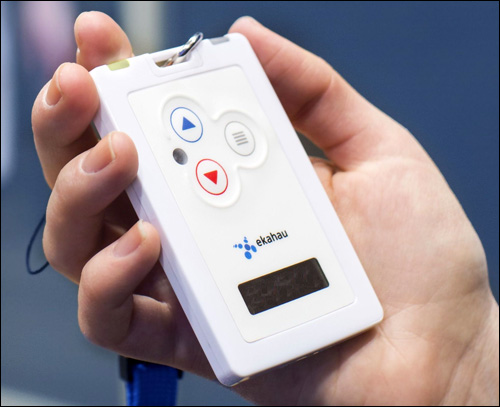Following the 2010 killing of a staff member by a patient, as well as other attacks against personnel, Napa State Hospital (NSH) implemented a radio frequency identification-based solution to ensure the safety of its workers in the areas in which they are most vulnerable, such as in the open-area campus. The solution, implemented by AT&T’s State and Local Government Solutions division and NetXperts, uses Ekahau‘s Wi-Fi-enabled B4 badge tags and Vision 2.0 real-time location system (RTLS) software to enable any worker to indicate an emergency situation, identify that individual’s location and issue an alert to dispatch and the hospital’s police force, as well as to coworkers via their own Wi-Fi badge tags. The California Department of State Hospitals (DSH), which manages the psychiatric hospital and four others within the state, is now rolling the technology out at two of those other sites.
Napa State Hospital, which has been in operation for more than 130 years, provides diagnostic, habilitation and rehabilitation treatment for its more than 1,300 psychiatric patients. Because NSH is a forensic facility, the majority of the mentally ill patients that it houses and treats have a history of violence. Most patients are court-mandated to be there, and many have committed at least one violent felony. Despite the serious nature of many patients’ psychiatric illnesses and tendencies toward violence, however, the campus itself consists of expansive lawns and shade trees, and many inhabitants are allowed to freely move around its 138-acre campus, or pass through accompanied by a staff member.

Although the gates and buildings are secured, personnel cannot always protect each other from attacks on the campus itself. In 2010, a patient strangled a female staff member on an outdoor patio of the campus.
As a result, the hospital sought a personal-duress system to ensure that if an incident occured, help would arrive quickly. AT&T’s State and Local Government Solutions division, the hospital’s IT services provider, served as the technology integrator for the implementation. NetXperts expanded the campus’ existing Cisco Wi-Fi network by installing additional access points to provide more dense coverage throughout the facility. The security treatment area (STA) alone now contains 1,500 such Wi-Fi nodes.
Each employee has his or her own Ekahau badge tag that transmits a unique ID number linked to that person’s identification in the Vision software, according to Mark Norris, Ekahau’s president. Staff members wear the device on a lanyard everywhere throughout the hospital campus.
At any given time while on campus, if an individual faces an emergency situation, he or she can pull the badge, causing it to transmit a Wi-Fi signal summoning help. The Vision software then sends a notification to the hospital’s dispatch unit, police on staff and other workers within the vicinity. Each staff badge found to be in the area vibrates, emits an audible tone, flashes and lists the individual’s location and name on its screen. This feature can reduce emergency response times, since personnel could be within seconds of the conflict and could thus reach the scene much more quickly than other aid responders. Notification is accomplished within a matter of seconds once the alert is triggered.
To ensure that staff members respond immediately, the hospital also installed sufficient directional signage so that individuals could see those signs in all directions around them, indicating the locations of other areas of the campus. What’s more, the facility also trimmed any trees or bushes that could block this signage. Thus, if employees receive an alert from a specific area of the campus, and if they are unsure where to go, they can immediately view signage pointing them to the correct location.
NSH has a total of 2,000 Ekahau badge tags for staff members and visitors. Typically, 800 badge tags are worn during each shift.
The installation was completed in late 2011, and was tested for nearly a year before being taken live in October 2012. Although no one at the hospital responded to requests for comments, a news report released this year indicates that the system proved beneficial during a recent emergency. On June 16, according to KPIX 5’s Web site, a nurse working at Napa State Hospital was assaulted by a male patient, but she was rescued by fellow staff members in the vicinity after she triggered an alert by pulling on her badge.
Norris says the software not only identifies the locations of all badges and distributes alerts to the proper devices, but also provides historical data. For example, after an emergency is resolved, management can review records of the response activity of every staff member within the vicinity, in order to better determine how a call was responded to, and then pinpoint areas in which additional training may be required.
The badge can typically provide location information within 8 to 15 feet. In some open areas, however—such as large lawns—that location detail is not as granular, simply because it does not need to be. The staff can visibly see the incident under way when it is taking place on the lawn, for instance.
The software also includes geofencing functionality. With this feature, Norris explains, a hospital can assign specific badges used by particular employees to zones in which they are authorized, and can receive alerts if a staff member enters the wrong area. Some of that functionality is currently being used by NSH, he says, though he is unable to provide specifics.

